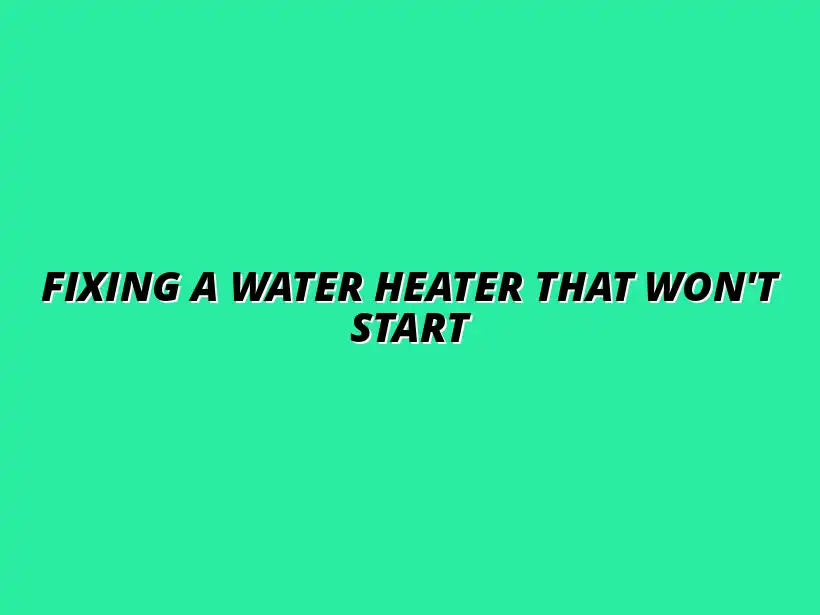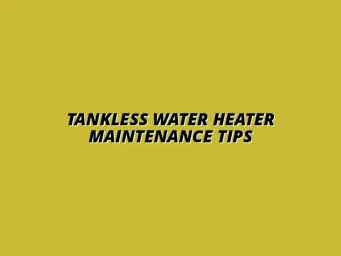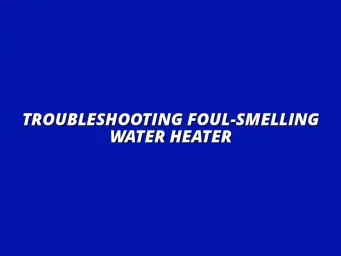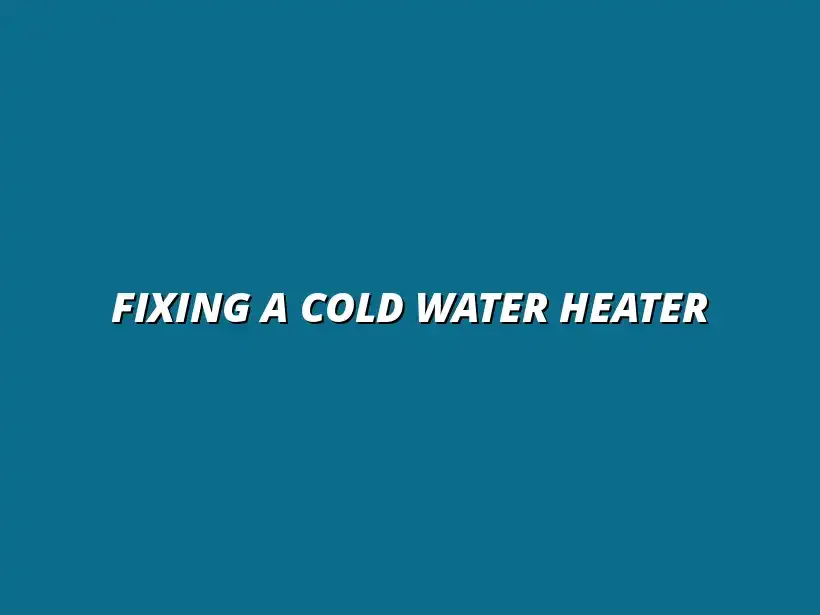
Fixing a Water Heater That Won't Start
Understanding the Basics of Water Heaters
When it comes to home comfort, understanding how water heaters work is essential. They are vital appliances that provide hot water for various needs like bathing, cooking, and cleaning. Knowing the different types of water heaters and how they function can help you make informed decisions about your home’s hot water supply!
Types of Water Heaters and Their Functions
There are three main types of water heaters, each serving its unique purpose. By grasping the differences, you can choose the best option for your home. Let’s explore these types together!
Conventional Water Heaters
Conventional water heaters, also known as storage water heaters, are the most common type found in households. They store a large volume of hot water in a tank, ready for use at any time. Typically, they come in sizes ranging from 20 to 80 gallons, making them suitable for families with varying hot water needs.
- Use a thermostat to maintain the water temperature.
- Have a limited supply of hot water; once it runs out, you’ll need to wait for it to refill.
- Can run on electricity, natural gas, or propane.
Tankless Water Heaters
Tankless water heaters, also known as on-demand water heaters, heat water directly without the use of a storage tank. When you turn on the hot water tap, cold water travels through a pipe into the unit, and a gas burner or electric element heats the water instantly. This means you have a continuous supply of hot water!
- Energy-efficient, since they only heat water when needed.
- Save space, as they are compact and can be mounted on walls.
- Have a longer lifespan compared to conventional heaters.
Heat Pump Water Heaters
Heat pump water heaters use electricity to move heat from the air or ground to heat water, rather than generating heat directly. This process makes them much more energy-efficient compared to traditional water heaters. They work best in moderate climates and can significantly lower your energy bill!
- Utilize renewable energy from the environment.
- Can be two to three times more efficient than conventional heaters.
- Typically require more space due to the heat exchange process.
Common Signs of Water Heater Issues
Water heaters can develop problems over time, and recognizing the signs early can prevent costly repairs down the line. It’s important to pay attention to any unusual symptoms, as they can indicate the need for maintenance or replacement. For more information on common issues, check out this helpful guide: common water heater issues explained. Here are some common issues to watch for!
Identifying a Non-Functional Water Heater
Sometimes, your water heater may stop working entirely. When this happens, you’ll notice a lack of hot water in your household. Here are a few signs indicating that your water heater might be non-functional:
- No hot water is available.
- Water is lukewarm or insufficiently heated.
- Strange noises, like banging or popping, coming from the tank.
Symptoms of a Water Heater That Won't Turn On
If your water heater isn’t turning on, it can be frustrating. Several factors could be at play. Common symptoms include:
- A tripped circuit breaker or blown fuse.
- Faulty thermostat settings.
- Issues with the gas supply (for gas heaters).
Being aware of these signs can help you troubleshoot effectively and determine whether you need professional assistance!
Advanced Troubleshooting Techniques for Persistent Issues
When a water heater refuses to operate despite basic troubleshooting, it’s time to dive deeper into advanced techniques. This section will guide you through specific methods for identifying and resolving issues, especially for electric and gas water heaters. Tackling these problems can help restore your hot water supply and save on costly repairs.
Remember, if you’re ever in doubt or feel unsafe performing any checks, it’s best to call in a professional. If you're experiencing a water heater leak, you can find emergency plumbing services here. Now, let’s explore some advanced troubleshooting techniques!
Inspecting Heating Elements in Electric Water Heaters
For electric water heaters, one common issue is a malfunctioning heating element. These elements are crucial because they heat the water in the tank. If you notice your water isn't getting hot, it may be time to inspect these components more closely.
- Signs of a faulty heating element include inconsistent water temperature, discolored water, or no hot water at all.
- To properly diagnose the issue, you'll need to test the heating elements with a multimeter.
- Regular checks can help prevent unexpected cold showers!
Identifying Signs of a Faulty Heating Element
Knowing what to look for can save you time and trouble. Some signs your heating element might be failing include:
- Water takes a long time to heat up.
- Strange noises coming from the heater.
- Water that’s too hot or not hot at all.
If you notice these issues, it's a good idea to test the heating elements as soon as possible.
Testing Heating Elements with a Multimeter
Using a multimeter is a straightforward way to check the heating elements. Here’s how to do it:
- Turn off power to the water heater at the circuit breaker.
- Remove the access panel covering the heating element.
- Set your multimeter to the ohms setting.
- Touch the multimeter probes to the heating element terminals.
- Check the reading; a value around 10-20 ohms indicates a functioning element.
Any significant deviation from this range likely means the element needs replacement.
Addressing Pilot Light Issues in Gas Water Heaters
For gas water heaters, the pilot light is key for functionality. If your heater is not producing hot water, a pilot light issue could be the culprit. Understanding how this system works can help you troubleshoot effectively.
Make sure to always follow safety protocols when dealing with gas appliances. Let’s take a closer look at how to handle pilot light problems!
Understanding the Role of the Pilot Light
The pilot light is a small flame that ignites the gas burner to heat the water. If it goes out, the burner won’t operate, leaving you with cold water. Here are a couple of vital functions:
- It provides a continuous flame to ignite the gas when needed.
- It serves as a safety mechanism that prevents gas buildup.
Knowing how to check and relight the pilot light properly can save you time and stress!
Steps to Relight a Pilot Light Safely
If the pilot light has gone out, follow these steps to relight it safely:
- Turn off the gas valve and wait a few minutes.
- Locate the pilot light assembly and the igniter button.
- While pressing the igniter, turn the gas valve to the “on” position.
- If the pilot lights, keep holding the button for about a minute.
- Release the button and make sure the pilot stays lit.
If it doesn’t stay lit, there may be more significant issues that need professional evaluation.
Examining the Anode Rod and Its Impact
The anode rod plays a vital role in preventing corrosion inside your water heater. Regular maintenance, including checking the anode rod, is crucial for extending the life of your water heater. For simple maintenance tips, see our guide on water heater maintenance made simple. If your heater is not functioning well, the anode rod might be to blame. Regular checks can make a difference in your water heater's lifespan!
Let’s discuss what the anode rod does and how to identify if it needs replacement.
Understanding Anode Rod Functionality
The anode rod is designed to attract corrosive elements in the water, which helps protect the tank from rusting. By sacrificing itself, it extends the life of your water heater. Here’s what to remember:
- Regular inspection can help you catch deterioration early.
- Replacing it every few years can significantly prolong your heater’s life.
Paying attention to the anode rod can save you from premature tank failure!
Signs of Anode Rod Deterioration
Look for these signs to determine if your anode rod is deteriorating:
- Rusty or discolored water.
- A foul smell coming from the hot water.
- Visible corrosion on the rod itself.
If you notice any of these issues, it might be time to replace the anode rod!
Frequently Asked Questions on Water Heater Problems
As we wrap up this section, let’s tackle some common questions that arise about water heater issues. Understanding these FAQs can provide clarity and help you make informed decisions!
How to Determine If My Water Heater Needs Replacement?
Knowing when to replace a water heater can save you a lot of hassle. Here are some indicators:
- Water heater is over 10-15 years old.
- Frequent repairs are needed.
- Inconsistent water temperature.
If you see these signs, consider consulting a professional. Finding a skilled plumber is essential for repairs; you can find local help here.
What Should I Do If My Water Heater Is Leaking?
A leaking water heater can cause damage to your home. Learning how to repair a leaking water heater pipe can be valuable. Find a guide on repairing a leaking water heater pipe. Here’s what to do:
- Turn off the power supply.
- Shut off the water supply.
- Inspect the area for obvious leaks.
- Contact a plumber for repairs.
Always address leaks promptly to prevent further damage!
Final Thoughts and Recommendations for Water Heater Maintenance
Taking care of your water heater can prolong its life and improve efficiency. Regular maintenance and timely troubleshooting can save you money and stress in the long run. Let’s look at some essential maintenance tips and when to seek professional help!
Regular Maintenance Tips to Prevent Future Issues
By following some simple maintenance routines, you can prevent many water heater problems:
- Flush the water heater annually to remove sediment build-up.
- Check the temperature settings regularly.
- Inspect the anode rod every couple of years.
Staying on top of these tasks can help you enjoy consistent hot water!
Flushing the Water Heater Annually
Flushing your water heater is a straightforward process that can greatly improve its efficiency. Here’s how:
- Turn off the power and shut off the cold water supply.
- Attach a hose to the drain valve and direct it to a floor drain.
- Open the drain valve and allow the water to flow out.
- Turn on the cold water supply to flush out any remaining sediment.
- Close the drain valve and restore power.
This routine helps keep your heater running smoothly!
Checking For Sediment Build-Up
Regularly checking for sediment build-up is essential. Sediment can cause inefficiency and lead to damage over time. Here’s what to do:
- Observe the water temperature; if it’s inconsistent, you may have sediment.
- Check for strange noises from the tank.
- Schedule a flush if you see signs of build-up!
Being proactive can prevent bigger issues down the road!
When to Call a Professional for Help
Sometimes, despite our best efforts, we need expert assistance. Knowing when to call a professional can save you time and frustration. Dealing with a leaky faucet? Check out these beginner tips or for bathroom faucets, see this guide.
- If you encounter persistent leaks or water quality issues.
- When repairs seem too complex or risky.
- If your water heater is old and requires replacement.
Don’t hesitate to reach out for help when needed!
Signs Indicating Professional Intervention Is Necessary
Be on the lookout for these signs that you should call a technician:
- Unusual noises from the heater.
- Water temperature problems that can’t be resolved.
- Frequent trips to the circuit breaker.
Addressing these signs early can prevent further complications!
Choosing the Right Plumber or Technician for Water Heater Repairs
Finding a skilled plumber can make all the difference. Consider these tips when choosing a professional:
- Look for licensed and insured technicians.
- Read reviews and ask for recommendations.
- Get multiple quotes to ensure you’re getting fair pricing.
This way, you’ll have someone you can trust to handle your water heater needs!




